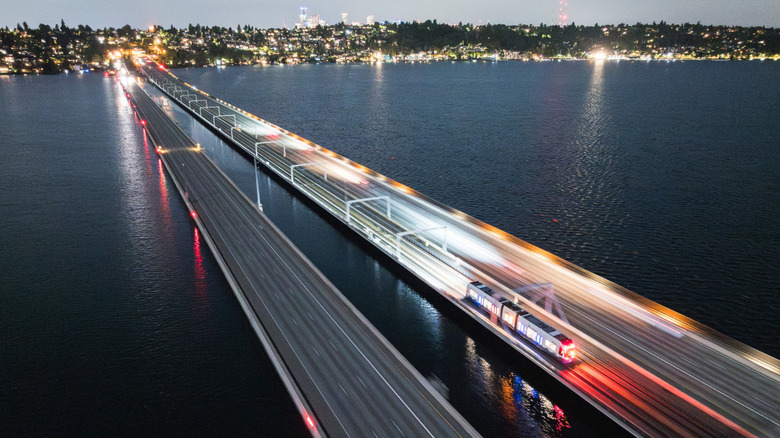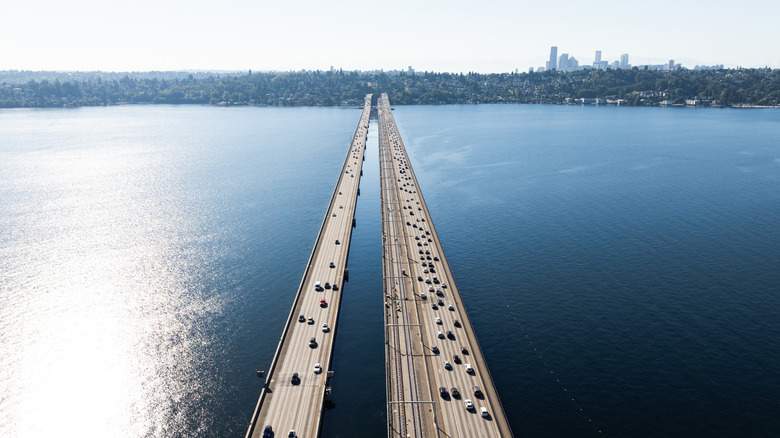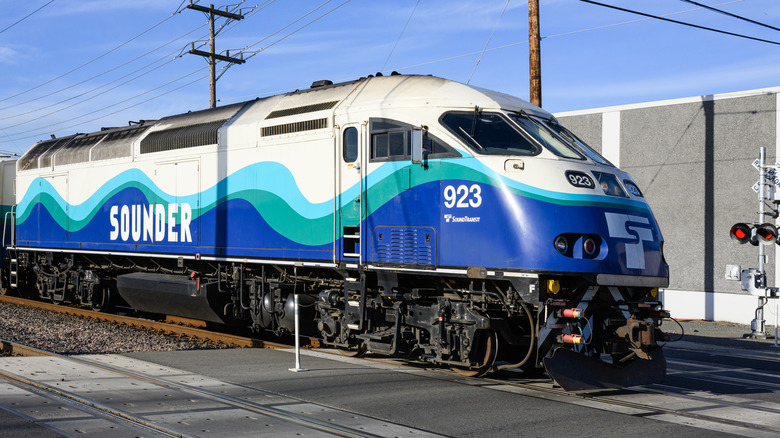Seattle Has A Powered Train That Can Cross A Floating Bridge - Here's How It Works
Trains pass over all types of bridges to get where they're going, including typical steel girder and truss bridges seen all across America, trestle bridges, and even viaducts (think the Hogwarts Express of Harry Potter fame). Now, in a world first, an electrically powered train has crossed a floating bridge across Lake Washington, which is also home to one of the longest floating bridges in the world. It happened in Seattle, when Link light rail, which is part of Sound Transit, took a light rail vehicle across the floating Homer M. Hadley Memorial Bridge under its own power.
The floating bridge used by Link light rail is not new, nor is it the first floating bridge in the world. These types of bridges were actually proposed more than 100 years ago, and the first reinforced concrete floating bridge was another bridge across Lake Washington near Seattle: the Lake Washington Floating Bridge, later renamed the Lacey V. Murrow Bridge, which opened in 1940. These types of bridges don't rest on the bottom of the body of water they span. Instead, they float on hollow pontoons made of concrete. There are several of these bridges in the Pacific Northwest, and around the world, including the Nordhordland Bridge in Norway and the Yumemai Bridge in Japan. None of these, however, are equipped to power trains.
How history was made
Sound Transit is the first in the world to run an electrically powered train across a floating bridge. The Homer M. Hadley Memorial Bridge, which was built in 1989, carries the westbound lanes of I-90, America's longest interstate highway. The bridge now boasts two tracks for the new 2 Line. Running a train across a floating bridge is considered by experts as one of the most complicated challenges in rail engineering due to the overhead power system required to operate the train. When testing is completed, two new stations will open to complete the line.
To test the rail on the Homer M. Hadley Memorial Bridge, the company took a single train across the bridge multiple times, starting at 5 mph and gradually increasing the speed to 55 mph. Testing was carried on at night so that the team could watch electrical arcing between the overhead wires and the light rain vehicle, which is expected. Sound Transit will continue testing between the last new stations until the line fully opens in early 2026.
Sound Transit's 2 Line
Beyond the logistics of powering a train across a floating bridge, why does this matter? You may know that the Seattle area is a major technology hub, with companies like Amazon and Google calling it home. But if you're not a local, you may not understand the challenging geography for tech workers. Lake Washington separates Seattle from Bellevue and Redmond, where Microsoft is headquartered. Every day, thousands of IT professionals cross Lake Washington via car or bus. The roughly 15 miles between Seattle and Redmond may not sound like a long way, but it can take commuters up to two hours by car on a bad day. Rail transportation is not currently available, but Sound Transit's Crosslake Connection, part of the new "2 Line," will change that.
Ten of the new line's 12 stations are already open, with the exception of perhaps the most highly anticipated portion: the station at Mercer Island (located on Lake Washington) and Judkins Park will complete the new line, fully connecting some of the biggest tech giants to Seattle.


